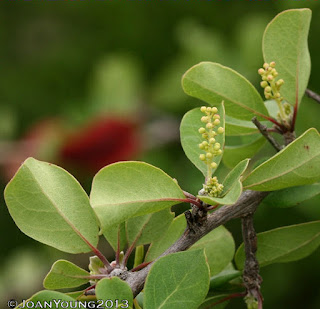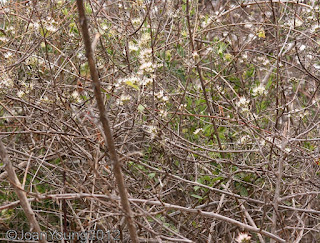Family Hyacinthaceae
Handsome, striking, unique, peculiar, these are the kind of words that are used to describe this unusual plant. Eucomis autumnalis is a deciduous, summer growing bulb. The bulbs are large (8-10cm diameter), ovoid in shape, and give rise to a rosette of large, broad, soft-textured, fleshy, wavy-edged leaves, about 12-35 cm long x 60-75 cm wide. The inflorescence is a dense cylindrical raceme on a stout stalk, crowded with up to ±125 starry yellowish-green flowers with a tuft of leaf-like bracts at the tip. The inflorescence pushes the overall height of the plant up to ±50-60 cm. Flowers are produced in mid to late summer (December to February). After pollination, whilst the seeds are developing inside the swelling ovaries, the flowers turn green and the inflorescence remains decorative into autumn. The fruit is a trilocular capsule containing shiny black rounded seeds.
The name Eucomis is derived from the Greek eukomos meaning beautifully haired, from the Greek eu- meaning well and kome hair of the head, and refers to the tuft of leaf-like bracts that crown the inflorescence. This same feature also gave it its English and Afrikaans common names. The specific name autumnalis refers to its flowering and fruiting time. It has acquired a number of synonyms over the years, where variants were defined as separate species but these are now regarded as part of the same species, or where the same plant has been given different names by different botanists.

Eucomis autumnalis is divided into three subspecies, most clearly distinguishable by the structure of the peduncle (stalk of the inflorescence) which is either club-shaped or cylindrical: Eucomis autumnalis subsp. autumnalis, (cylindrical) syn. Fritillaria autumnalis, Eucomis undulata, which occurs on mountain slopes, in open grassland and forest margins in the Eastern Cape, Northern Province, Zimbabwe and Malawi; Eucomis autumnalis subsp. clavata, (club-shaped or clavate) syn. Eucomis robusta, E. clavata, which grows in open grassland and marshes in KwaZulu-Natal, Lesotho, eastern Free State, Mpumalanga, Gauteng, Northern Province North West Province and Botswana; and Eucomis autumnalis subsp. amaryllidifolia, (linear leaves, club-shaped peduncle) syn. Eucomis amaryllidifolia, which grows between rocks on mountain slopes of the western Free State and Eastern Cape.
Eucomis is a member of the Hyacinthaceae (hyacinth family), formerly part of the Liliaceae (lily family), a family of perennial bulbous herbs consisting of ±46 genera and ±900 species found in Africa, Eurasia and North America but most richly represented in southern Africa and in the Mediterranean region to south west Asia. Related species known to South African gardeners include Lachenalia mathewsii, Veltheimia bracteata and Scilla natalensis while species more familiar to northern hemisphere gardeners include the hyacinth, Hyacinthus orientalis and the bluebell, Hyacinthoides non-scripta. The genus Eucomis consists of approximately eleven species that occur in southern Africa, Zimbabwe and Malawi. There are approximately ten in southern Africa, that occur in all eight provinces of South Africa, and in Botswana, Lesotho and Swaziland, where they are found widespread in grassland, forest, swamps and river banks but are absent from the drier areas.

Although the bulb is toxic, Eucomis autumnalis is used medicinally in South Africa. Decoctions of the bulb in water or milk are usually administered as enemas for the treatment of low backache, to assist in post-operative recovery, and to aid in healing fractures. Decoctions are also used for a variety of ailments, including urinary diseases, stomach ache, fevers, colic, flatulence, hangovers and syphilis, and to facilitate childbirth. The subspecies clavata is also used for coughs and respiratory ailments, biliousness, lumbago, blood disorders, venereal diseases and to prevent premature childbirth. Several homoisoflavones are found in Eucomis autumnalis, and flavonoids are known for their anti-inflammatory and antispasmodic action. It also contains some steroidal triterpenoids and they are known to be beneficial in wound therapy.



















































